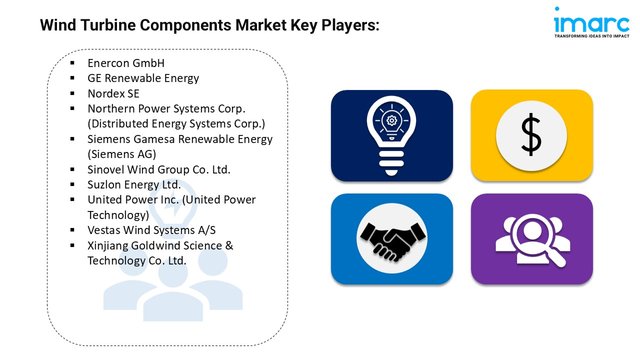
Market Overview:
The wind turbine components market is experiencing rapid growth, driven by turbine scaling & enhanced performance, supply chain localization & diversification and digitalization & predictive maintenance. According to IMARC Group’s latest research publication, “Wind Turbine Components Market Report by Component (Rotator Blade, Gearbox, Generator, Nacelle, Tower, and Others), Wind Turbine Type (Grid Connected, Standalone), Wind Farm Type (Onshore, Offshore), and Region 2025-2033“, The global wind turbine components market size reached USD 135.3 Billion in 2024. Looking forward, IMARC Group expects the market to reach USD 236.0 Billion by 2033, exhibiting a growth rate (CAGR) of 6.05% during 2025-2033.
This detailed analysis primarily encompasses industry size, business trends, market share, key growth factors, and regional forecasts. The report offers a comprehensive overview and integrates research findings, market assessments, and data from different sources. It also includes pivotal market dynamics like drivers and challenges, while also highlighting growth opportunities, financial insights, technological improvements, emerging trends, and innovations. Besides this, the report provides regional market evaluation, along with a competitive landscape analysis.
Grab a sample PDF of this report: https://www.imarcgroup.com/wind-turbine-components-market/requestsample
Our report includes:
Factors Affecting the Growth of the Wind Turbine Components Industry:
The wind turbine components market experiences significant growth driven by the tireless tendency for market turbine scaling and the discovery of enlarged performance. This dynamic is fuel of the compulsory industry mandatory to maximize energy catches and reduce the cost of energy level (LCOE). In addition, the development of rapidly large rotary agents, long towers and high capacity generators are able to utilize wind turbines strong and more consistent wind resources. Aerodynamically is important for adapting leaf design, using advanced materials such as carbon fibers and to improve driving efficiency. Increasing demand for advanced control systems, sensors and surveillance technologies enables real -time optimization and future maintenance. Emphasis of developing strong and long -term operating life for rapid weather conditions and long -term viability of wind power projects is important. Increasing direct driving turbines and super-leading generators simplifies the driving system and improves efficiency. The development of floating wind turbines unlock the ability to deep water offshore windshields. The increasing demand for altitude storage storage, gearboxes and power electronics runs innovation in component design and production. Integration of digital twin technology and simulation tools enables virtual testing and customization of turbine components. This scaling trend is not just about the manufacture of large turbines; It is about unlocking more energy dividends and pursuing engineering boundaries to increase the economic viability of wind energy.
The wind turbine component market supply chain is a strong tendency for location and diversification, which is inspired to reduce geopolitical risks, reduce the dependence on concentrated sources of supply and increase the flexibility of the supply chain. There is fuel with the increasing recognition of the importance of developing dynamic regional production hubs and developing local supply chains to reduce transport costs and leadership. In addition, the component is important for diversifying suppliers and focusing on developing backup production functions and reducing the effect of potential disturbance and ensuring stable supply of important components. The increasing demand for low lead time and better accountability runs to use smooth production practices and located warehouses. The emphasis on developing standardized component design and modular production processes increases flexibility and scalability. Increasing digital supply chain management devices and platforms improves the visibility and coordination in the price chain. The development of regional centers for skills for the production of wind turbine components promotes local economic development and employment generation. The increasing demand for durable and morally acidic materials runs to use local suppliers and responsible production practices. Focuses on building strong and collaborative relationships with local suppliers, increasing the flexibility of the supply chain and promoting long -term partnerships. This location change is not only close to purchasing components; It is about creating a strong and flexible supply chain that supports the long -term development of the wind power industry.
Wind Turbine Components Market is experiencing increasing volume of market digitalization and future maintenance, which is inspired by the need to adapt operating efficiency, reduce downtime and expand the lifetime of the component. This dynamic IoT sensor, data analysis platforms and remote monitoring systems are provided fuel, which provides real -time insight into the component performance and position. In addition, the focus is on developing future maintenance algorithms and machine learning models enables the expectations of potential errors and planning of active maintenance interventions. The increasing demand for digital twin techniques and simulation tools is activated to adapt to virtual testing and component performance. The emphasis on developing automatic diagnostic systems and self -healing mechanisms improves reliability and reducing the cost of maintenance. Increasing the tools for improved realities (AR) and Virtual Reality (VR) increases distant maintenance and exercise functions. The development of cloud -based platforms and mobile apps is enabled external access to data and control functions. The increasing demand for data -driven insights into component performance and operational efficiency runs to use advanced analyzes and reporting tools. The focus on developing standardized data interfaces and communication protocols enables spontaneous integration with other automation systems. This digitization station is not just about adding sensors; It is about creating intelligent and connected systems that optimize the component performance and reduce the operational disruption.
Leading Companies Operating in the Global Wind Turbine Components Industry:
